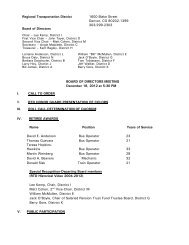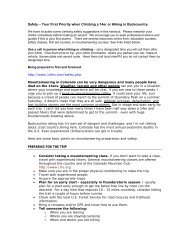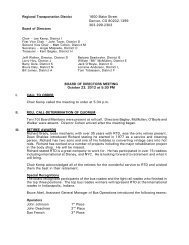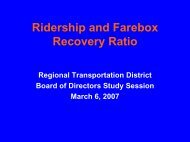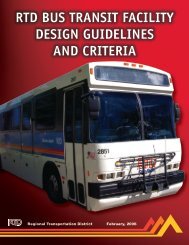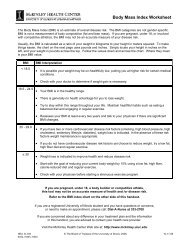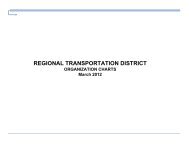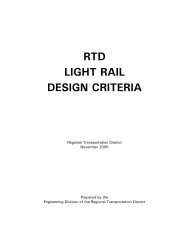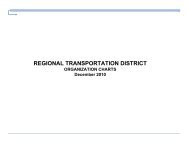Commuter Rail AC Electrification Load-Flow Simulation Report - RTD
Commuter Rail AC Electrification Load-Flow Simulation Report - RTD
Commuter Rail AC Electrification Load-Flow Simulation Report - RTD
You also want an ePaper? Increase the reach of your titles
YUMPU automatically turns print PDFs into web optimized ePapers that Google loves.
<strong>Commuter</strong> <strong>Rail</strong> <strong>AC</strong> <strong>Electrification</strong> <strong>Load</strong>-<strong>Flow</strong> <strong>Simulation</strong> <strong>Report</strong> Revision 1<br />
2.0 INTRODUCTION<br />
2.1 PURPOSE OF THE STUDY<br />
<strong>RTD</strong> has proposed electrical multiple unit (EMU) train operation on the East Corridor, Gold Line,<br />
and North Metro Corridor. All three corridors originate at the Denver Union Station (DUS) and<br />
radiate out to the East, West, and North of Denver, respectively, totaling approximately 53 route<br />
miles.<br />
The corridors are being considered for electrification at 25 kV, 60 Hz, <strong>AC</strong>, using a traction power<br />
supply system comprising either an autotransformer-fed (ATF) system, also known as 2x25 kV<br />
system, or a direct-feed system, sometimes referred to as 1x25 kV system. The purpose of this<br />
study is to evaluate the autotransformer-fed electrification system for application to the three<br />
aforementioned commuter rail corridors. In order to evaluate the autotransformer-fed system, a<br />
comprehensive computer-aided load-flow simulation study was performed. The study took into<br />
account all relevant electrification system parameters, including the track alignment data, the<br />
rolling stock parameters, and the commuter rail operational data.<br />
The results of the load-flow simulations will provide the necessary data for development of a<br />
conceptual design for the power supply system and will enable the design team to perform the<br />
following tasks:<br />
• Verify the required number of substations and the required number of traction power<br />
transformers in each substation<br />
• Verify preliminary locations of the traction power equipment including traction power<br />
substations, paralleling stations, and the switching station<br />
• Determine ratings of major equipment, such as substation transformers and<br />
autotransformers<br />
• Verify conductor sizes and materials for the overhead catenary system and the feeder<br />
system<br />
• Calculate substation power demands and energy consumption. These results may be<br />
used for establishing the power utility supply requirements and as an input to estimating<br />
operating costs of the traction electrification system.<br />
This report documents the load-flow simulations performed by Front Range System Consultants<br />
(FRSC) for the three <strong>RTD</strong> <strong>Commuter</strong> <strong>Rail</strong> Corridors to be electrified.<br />
2.2 SCOPE OF THE STUDY<br />
The scope of the study includes the East Corridor, Gold Line Corridor, and the North Metro<br />
Corridor, each originating from the Denver Union Station. The alignment data used for<br />
modeling and simulation of each corridor were obtained from information provided by <strong>RTD</strong>, as<br />
follows:<br />
• Denver Union Station data, developed by DMJM/Harris<br />
• East Corridor data, developed by PBS&J<br />
• Gold Line data, developed by CH2M Hill<br />
• North Metro Corridor data, developed by URS<br />
02/27/2009 FRSC Page 3 of 250




